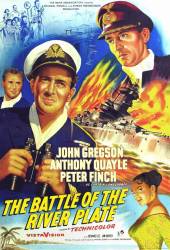Corrected entry: Near the end of the film, the crew of the Sheffield are ordered to stand at attention, salute and "face to starboard!" They are all facing to port, including the captain, who gave the order.
Corrected entry: Throughout the movie, Commodore Harwood is shown wearing Rear Admiral rank insignia. An RN Commodore is identified by a single broad ring and eye.
Correction: Unfortunately I have to correct myself, with new information obtained from a senior naval officer. Commodore is a Royal Navy rank that dates to the mid-17th century. It was first used in the time of William III. At that time there was a need for officers to command squadrons of ships, but their Lords of the Admiralty did not wish to create new admirals. Captains assigned squadron command were given the title of Commodore, but it was not an actual rank. The officer so designated kept his place on the list of Captains. In 1748 it was established that Captains serving as Commodores were equal to Brigadier Generals, even though the former remained an administrative rank. Still remaining a temporary rank, Royal Navy Commodores were then split into two classes. Those of the first class had a Captain under them to command their ship. Those of the second class commanded their own ship as well as the squadron. From 1783, Commodores of the first class were allowed to wear the uniform of a Rear Admiral, a distinction which continued with some variation until the two classes of Commodore were brought together again in 1958. Commodores First Class, while wearing the sleeve stripes of a Rear Admiral, had gold lace-covered epaulettes and shoulder-boards with a crown, two stars and anchor (also worn by other Commodores but only with formal uniforms). Commodores Second Class wore a single 1.75 in. wide row of lace below a ring measuring 1.75 in. in diameter on both sleeve and shoulder-board (and this is the insignia worn by modern commodores).
Corrected entry: When the captured British officer is being transfered from the Altmark to the Graf Spee you can see the Radar rotating on the Spee, but the Germans did not have Radar at this early stage of the war as it was a British invention and only they had it for most of WWll.
Correction: Absolute rubbish. Radar was fitted to the Graf Spee in 1937, two years before she was sunk. See http://www.radarworld.org/germany2.html.
Corrected entry: When "HMS Cumberland" finally arrives, the RN crews all cheer the arrival of a 3-funnelled cruiser - but I'm sure there were no turrets visible (so not much use really). Its only a brief shot - was the ship (actress?) on her way to the scrapyard?
Correction: H.M.S Cumberland was converted to a training ship before the film, so her main armament was removed.






Correction: The crew do face to starboard. They face left on the screen, but that's because the camera is filming from the bow.
Necrothesp